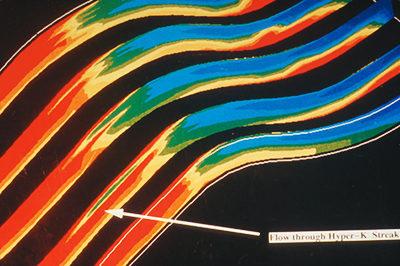Simulation Software
NASA is one of the pioneering organizations advancing the art of computational mechanics, which involves creation of mathematical models of a product design and testing various configurations by computer simulation before settling on a final design. Initially used by NASA to model designs of flight vehicles, the technique has expanded enormously over the last two decades to embrace calculation and visual imagery of forces and phenomena that cannot be simulated in conventional facilities, such as wind tunnels. Its use has similarly grown from air and space applications to cover a great variety of non-aerospace products from autos to rollercoasters to medical equipment.
These advances have been made possible by a great wealth of software developed by government agencies and private companies. The Small Business Innovation Research (SBIR) program, through which NASA encourages commercialization of technologies that have both public and private sector applications (see page 108), has been particularly productive of advanced software development. An example in the field of computational simulation is the work of Computational Mechanics Company, Inc. (COMCO), Austin, Texas. Over the past decade, COMCO has worked on several NASA SBIR contracts for computational mechanics modeling and simulation software, and a number of COMCO's products have successfully been commercialized.
The company's basic software is the PHLEX™ family of hp-adaptive finite element analysis programs, a library of object-based modules that may be linked and extended to create job-specific codes across a broad spectrum of engineering disciplines. NASA's research assistance was integral to the development of PHLEX, says COMCO; several NASA SBIRs allowed the company to improve and expand upon the PHLEX code and make it work for a variety of computational mechanics problems, including problems in both fluid and solid mechanics. Traditional general purpose finite element software requires the expertise of an analyst to appreciate the quality of the numerical simulations independently of the quality of the design. PHLEX-based software is designed to remove the uncertainty about the quality of the solution by estimating the solution's error and producing, automatically, the optimal hp-adapted mesh for the accuracy the user chooses.
A commercial offshoot of COMCO's SBIR work is ProPHLEX Developers Toolkit™, introduced in 1995. The primary targeted users are major industrial corporations (for mechanical design applications) and universities (for research and mechanical engineering training).
Ford Motor Company has supported ongoing development to produce a companion product, PHLEXsolid™, and make it compatible with NASTRAN, the NASA-developed standard finite element analysis code used by Ford in auto design. Ford seeks to couple NASTRAN capabilities with the hp-adaptive and Residual Error Estimation features of the PHLEX library. Says a Ford official: "hp-adaptive finite element analysis is one of the key enabling technologies in Ford's drive to reduce the concept-to-market cycle."
Another spinoff product is UNISIM, a PHLEX-based code for analyzing underground flows in oil reservoirs. Developed by COMCO with funding from Texaco Inc, UNISIM is a finite element simulator that combines the hp-adaptivity feature with parallel processing. Designed to obtain accurate numerical pressure and saturation solutions associated with large oil fields, the software models the complicated dynamics of horizontal and vertical wells used to inject water into reservoirs and force more of the oil to the producing wells.
PHLEX, ProPHLEX Developers Toolkit, PHLEXsolid, and UNISIM are trademarks of Computational Mechanics Company.

Workers at a Texaco oil field drill a vertical oil well. Texaco's oil production is aided by a computational simulation code called UNISIM.

A Texaco inspector performs a routine quality control check.

UNISIM simulation software produces imagery and data for pressure and saturation solutions.













